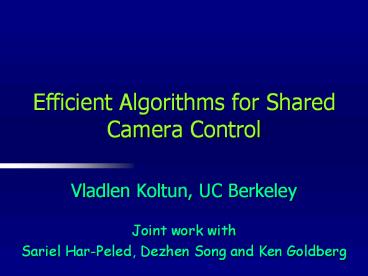Vladlen Koltun, UC Berkeley - PowerPoint PPT Presentation
Title:
Vladlen Koltun, UC Berkeley
Description:
Vladlen Koltun, UC Berkeley. Joint work with. Sariel Har-Peled, Dezhen Song and Ken Goldberg ... Song, van der Stappen and Goldberg (2002), O(n2) Our work ... – PowerPoint PPT presentation
Number of Views:50
Avg rating:3.0/5.0
Title: Vladlen Koltun, UC Berkeley
1
Efficient Algorithms for Shared Camera Control
- Vladlen Koltun, UC Berkeley
- Joint work with
- Sariel Har-Peled, Dezhen Song and Ken Goldberg
2
Robotic Webcameras
- Positioned at sites of wide interest
- Pan, tilt, zoom can be controlled on-line
- Existing implementations users queue
3
ShareCam
- Shared on-line camera control
- Geometric algorithms for finding the optimal
camera frame
4
Related Work
- Shared on-line control over a single mechanism
- Industrial robot arm Goldberg, Chen, et al.
- Waste cleanup system Cannon, McDonald, et al.
- Tele-Actor Goldberg, Song, et al.
- Algorithms we describe are relevant in these
scenarios as well
5
Contribution
- Song, van der Stappen and Goldberg (2002), O(n2)
- Our work
- Exact - O(n3/2 log3n)
- e-approximation - O(n logn)
- Discretizing zoom values
- Fixes the size of the camera rectangle
- Two degrees of freedom (center point)
6
Finding the Optimal Frame
- Idea Maximize user satisfaction
- Find a way to evaluate the satisfaction of a
given user with a given camera rectangle - Compute rectangle that maximizes cumulative user
satisfaction
7
Individual User Satisfaction
- Intersection over maximum metric
- Intersection Area
- Maximum Area
user
camera
8
Individual Satisfaction Function
Intersection (useri,cam(x,y)) Maximum
(useri,cam(x,y))
SATi(x,y)
useri
(x,y)
9
Individual Satisfaction Function
Intersection (useri,cam(x,y)) Maximum
(useri,cam(x,y))
SATi(x,y)
useri
(x,y)
10
Global Satisfaction Function
- SAT(x,y) ?i SATi(x,y)
- We are searching for (x,y) that maximizes SAT(x,y)
11
Approximation Algorithm
- For a given egt0 and every individual satisfaction
function, consider its level sets at O(1/e)
heights
12
Approximation Algorithm
- For a given egt0 and every individual satisfaction
function, consider its level sets at O(1/e)
heights
13
Approximation Algorithm
- Construct rectilinear paths between the level
sets - Decompose into rectangles
14
Approximation Algorithm
- The weighted rectangles almost approximate the
satisfaction function
15
Approximation Algorithm
- We have a collection of weighted rectangles
- We locate the most heavily covered point
- The global satisfaction value of this point is at
least (1-e) of the optimum
16
Approximation Algorithm
- To locate the heaviest point
- Sweep the plane with a vertical line
- Rectangles define weighted intervals on the line
- Maintain the heaviest point on the line using a
segment tree - During the sweep, intervals are inserted and
removed
17
Analysis
- The number of slices is O( log(1/e)/e )
- The number of rectangles (per function) is O(
log(1/e)/e2 ) - The overall number of rectangles is N
O( n log(1/e)/e2 ) - Every update of the segment tree during the sweep
is O(log N) - Overall running time is O(N log N)
18
Exact Algorithm
- Sweep the satisfaction functions with a vertical
line - Maintain the global satisfaction function along
the line with a KDS
19
Exact Algorithm
- Treat these satisfaction values as points moving
along vertical lines in 2-D - Maintain the upper hull of these points using a
kinetic data structure
20
Exact Algorithm
- To avoid handling O(n2) events, partition points
into n1/2 batches - Each batch maintains an additional value the sum
of long functions - When a long function changes we just update this
value - When a short function changes we rebuild the
kinetic data structure
21
Exact Algorithm
- The number of events processed by each kinetic
data structure is O(n1/2) - The kinetic data structures are rebuilt O(n)
times - The overall running time is O(n3/2 log3n)
22
Implementation
- The approximation algorithm becomes faster than
the algorithm of Song et al. only when n is in
the hundreds of thousands. - The bottleneck is updating the segment tree
during the sweep. Each insertion or deletion
takes O(log N), but there are 2N of them, and N
is at least 50n
23
Implementation
24
Work in progress
- Hardware-assisted algorithm
- Continuous zoom range
- More than one camera frame
- Dynamic maintenance, obstacles, weighted users
...
25
Thank you































